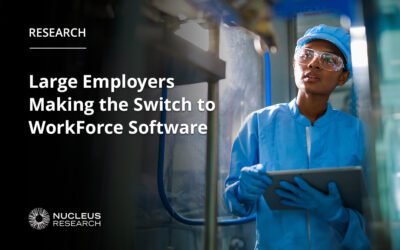Three Ways to Improve the Employee Experience for Deskless Workers

Whether they’re out on the sales or factory floor, in the field, or on the road, deskless workers are essential to the success of many organizations. Despite their significance, this workforce population frequently experiences challenges like inconsistent communication, rigid policies, and outdated technology. With Millennials and Generation Z now comprising much of this workforce, organizations must address their technological, personal, and professional needs through effective workforce management solutions.
According to Gallup, engaging employees can result in a 41% reduction in absenteeism, a 24% decrease in turnover, and a 17% increase in productivity and is a strong focus for organizations moving forward. Despite the benefits of a highly engaged workforce and increasing investments toward it, many employers still aren’t providing the kinds of work experiences frontline staff have come to expect and deserve.
Findings from our Third Annual Employee Experience Study reveal that while many employers are aware of the drive to provide better employee experience, they lack the technology needed to support their workforce needs.
To thrive in the global economy, employers must find meaningful ways to improve the employee experience. This means providing usable, functional workforce management technology that allows deskless workers to stay connected and engaged on the job.
Here are three ways to get started with improving the employee experience for deskless workers in your organization:
1. Provide Greater Scheduling Flexibility
Effectively scheduling employees is an ongoing struggle for employers and, when improperly managed, can be a point of contention amongst employees. That’s because scheduling affects not only how efficiently an organization runs but, ultimately, how people feel about their work. Overstaffing wastes resources, while understaffing increases workload, stress, and burnout.
Despite the importance of flexible scheduling, 31% of employees report that their employer doesn’t offer it. Further, many employees still rely on outdated or manual methods to access their schedules.
Utilizing employee scheduling software can streamline scheduling processes. Offering more flexible options like modifiable calendars and shift swapping significantly enhances the employee experience. It allows workers to more effectively balance personal responsibilities with their job commitments.
2. Open the Lines of Communication
For deskless workers, staying up to date on company announcements, receiving directives, and connecting with superiors can be difficult. Similarly, it can be hard for organizations to get a sense of how their employees are doing and feel about their work, especially when they’re far away from HQ, which can lead to stress, anxiety, and lower productivity.
Centralized communication platforms enable real-time communication between deskless workers and management. This seamless communication ensures that employees are always up to date on company announcements, receive directives promptly, and can connect with superiors easily. Regular updates and feedback loops are essential. They help reduce stress and increase employee engagement by engaging and supporting workers in the moments that matter most.
3. Equip Employees with the Tools Needed to do Their Jobs
Every employee’s needs are different, but the ability to do their job successfully is often hindered by manual, outdated, or one-size-fits-all solutions.
Manual processes and outdated systems often hinder job performance. Investment in updated workforce management software ensures operational efficiency and job satisfaction among deskless workers. Organizations are now facing growing pressure to digitize their internal operations. Employing technology aligning with this trend makes a strong case for enhancing the overall workforce experience. A modern approach improves efficiency and is a strong selling point in retaining top talent.
Employee Experience for Deskless Workers
Creating robust employee experiences is crucial for organizational resilience. Organizations need modern workforce management software to improve engagement, productivity, and satisfaction among deskless workers. By adhering to these strategies and using comprehensive workforce management software, employers can meet the expectations of their deskless employees, fostering a productive and engaged workforce.
To learn more about how employers can better meet the needs of their deskless workforce, read our Third Annual Global Employee Experience Study.
Subscribe to The WorkForce Blog
Learn the art and science of maintaining productive, happy, engaged employees.
Discover More
Nucleus Insights from WorkForce Customers Research Note
Nucleus Research interviews WorkForce customers who validate why we’re ranked the #1 WFM enterprise vendor for 10 consecutive years.
Elevate Employee Experience: Checklist for Operational Leaders
Get the practical steps and technology functionalities operation leaders need to improve their employees’ work experiences.
Streamlining Complex Workforce Compliance Requirements Boosts Productivity
Discover how workforce compliance software helps EMEA organisations navigate complex legislation, enhance compliance and boost operational efficiency.



